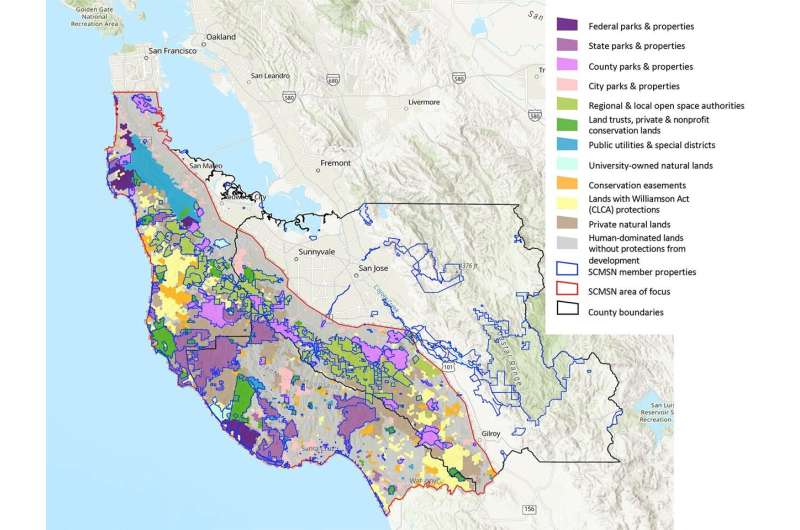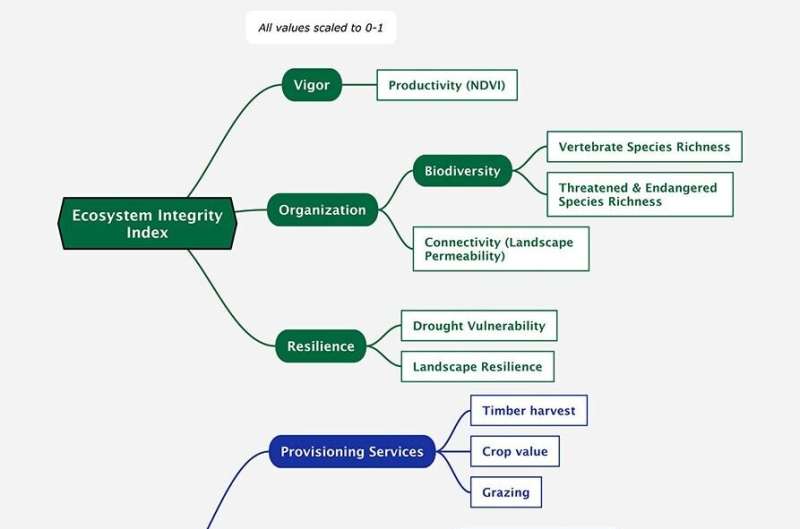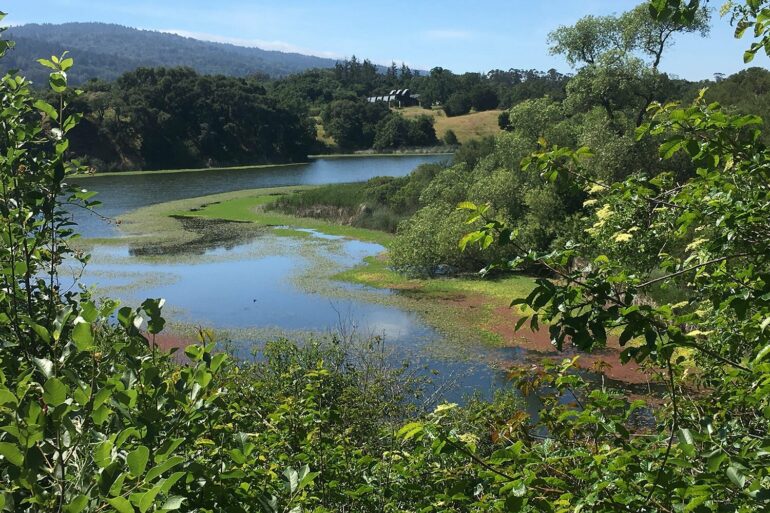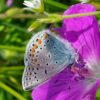The traditional conservation paradigm of “leaving nature alone” can be unrealistic and counter-productive, especially in a time of increasingly rapid ecosystem change, according to a new study by Stanford University scientists and colleagues, published April 6 in Nature Sustainability. The research argues that new awareness of land stewardship’s benefits is critical for ecosystem health within conserved landscape parcels and beyond their boundaries.
The researchers made their case using the Santa Cruz Mountains, which are a biodiversity hotspot and an area that has been highly disturbed by human activity. The team developed a socioecological health assessment and digital mapping tool focusing on this area in partnership with members of the Santa Cruz Mountains Stewardship Network. The network includes 24 land stewardship organizations: NGOs, state and county parks, a federal land agency, timber companies, an Indigenous tribe, and Stanford Stanford School of Humanities and Sciences’ Jasper Ridge Biological Preserve.
The resulting Sustainable Landscape Health Assessment project identifies the region’s social and ecological indicators in a single geospatial resource for planning and coordinating stewardship and conservation measures.
“We wanted a way to visualize and understand the current state of the Santa Cruz Mountains ecosystem to keep it healthy and serve the people of the region,” said study author Anthony D. Barnosky, now professor emeritus at the University of California Berkeley, who was involved in this study while executive director of the Jasper Ridge Biological Preserve. “As a university partner and member of the Network from the beginning, Jasper Ridge had the interest, expertise, and facilities to develop a socioecological health model and assessment for use by Network members, combining academic research with a much-needed practical application.”
Stanford News discussed the research with the study’s lead author, Nicole E. Heller, Ph.D. ’05, former director of conservation science at Peninsula Open Space Trust and now associate curator at the Carnegie Museum of Natural History; Kelly McManus Chauvin, a research scientist at the Hadly Lab, who helped lead the project when she was a postdoctoral researcher at Stanford’s Jasper Ridge Biological Preserve during this project; Dylan Skybrook the key investigator at the Santa Cruz Mountains Stewardship Network; and Barnosky.

This map is an approximate visualization of the diverse open space land management entities around and within the Santa Cruz Mountains. Properties related to members of the Santa Cruz Mountains Stewardship Network are outlined in blue. © Heller et al, Nature Sustainability (2023). DOI: 10.1038/s41893-023-01096-7
What exactly do you mean by conservation ‘stewardship?’
Skybrook: Sometimes we use the term “stewardship” to mean the acquisition of land and major restoration projects. But we also use it to mean the regular maintenance-level efforts needed to ensure that ecosystems stay healthy.
For the public, that stewardship can be invisible. Hikers in state parks, for instance, are often unaware of the immense amount of work that went into purchasing the land, designing the trails and locations of the parking lots, creating interpretive signage, or cleaning up the land before it was turned into a park. Land needs to be stewarded in an ongoing way with invasive species removal, prescribed fire, creek restoration for fish passage, and so on.
How is stewardship of conserved landscapes better than leaving that nature to its own devices?
Heller: Conservation science has a bias toward seeing nature as separate from people—the “leave nature alone” paradigm. We can put a fence around a piece of land and protect it from development, but that doesn’t mean it will protect the species and habitats there. They are still vulnerable to invasive species, climate change, and other stresses in the larger landscape. Stewardship both inside and outside conservation sites plays an important role in managing stresses and helping ecosystems be more resilient.
Barnosky: We have changed the operating system of the planet through our growing population, our consumption of natural resources, our changing of the climate, and our altering ecosystems. The places that species have occupied for millennia have changed so fast that the species can’t adapt quickly enough. So, species either must move or die out. That movement requires stewardship; we need to ensure the existence of corridors or we will have to move species ourselves.
Why is stewardship of conserved ecosystems underfunded and understudied?
Heller: The land conservation community has historically focused on “bucks for acres.” Often land has been purchased and protected but active management—which may be required to retain their unique values—has not been a funding priority. This situation is changing. Conservation land trusts and others are creating stewardship plans and endowments as part of conservation and these organizations are increasingly recognizing that to meet the diverse needs of community, conservationists need to work directly with land stewards.
McManus Chauvin: Many of the organizations we work with are used to coming under public scrutiny. If a prescribed burn hops a fire line, for example, even if no damage results from it, it is always a local news story. Thus, land managers have grown to be wary of how their actions might be interpreted and are hesitant to share data that might be construed in a way they did not intend it to be. We have worked carefully to ensure that all our decisions about what to include, and what to share, are made with the full support of the network, which has helped to engender trust. A second issue is just that much of these data are not centralized or collected consistently across many different organizations.

A figure outlining the metrics included in the Sustainable Landscape Health Assessment Framework. This framework was determined through scientific review, data collection, expert consultations, and collaboration between network members. © Heller et al, Nature Sustainability (2023). DOI: 10.1038/s41893-023-01096-7
A socio-ecological health assessment was created for the network instead of a traditional ecosystem health study. Why?
Heller: Ecological health frameworks typically focus on measuring and tracking biophysical indicators, which are elements of the system that we may want to remain abundant such as the status of select wildlife, plant species, and habitat types. Our framework includes biophysical indicators but also adds a human support lens because stewardship plays such an important role in land health.
McManus Chauvin: Humans have rarely been considered as an input to ecosystem health assessments. We chose three lenses through which we view the landscapes of the network. The first two lenses—ecosystem integrity and ecosystem services—are well established in frameworks for health assessment. Our third—stewardship support—is our attempt to bring human service into the health equation.
We are calling for collaborative research with social scientists to understand people as ecological actors through land stewardship and explore how those ecological interactions scale up to local and regional effects. Conservation science must become more social-ecological, informed by interdisciplinary and transdisciplinary perspectives.
How will the SLHA be used?
Skybrook: Part of the purpose of the Santa Cruz Mountains Stewardship Network is to help member organizations think about stewardship at a landscape or regional scale, instead of only thinking about properties each organization is responsible for. The digital mapping resource and the SLHA now provides data at that big-picture systemic scale so that land managers might have broader context for their decisions.
Barnosky: Jasper Ridge is one of the few protected ecosystems on the east flank of the Santa Cruz Mountains. To understand nature and steward it in these rapidly changing times, and keep nature vibrant for future generations, Jasper Ridge is the most important “laboratory” that Stanford has. But we need to know more about how to steward nature the right way, and what our ultimate stewardship effects on ecosystems will be, and that’s where the SLHA, and hopefully more work like it, can help.
More information:
Nicole E. Heller et al, Including stewardship in ecosystem health assessment, Nature Sustainability (2023). DOI: 10.1038/s41893-023-01096-7
Provided by
Stanford University
Citation:
Appreciating human stewardship of nature: Study challenges traditional conservation paradigm (2023, April 7)



